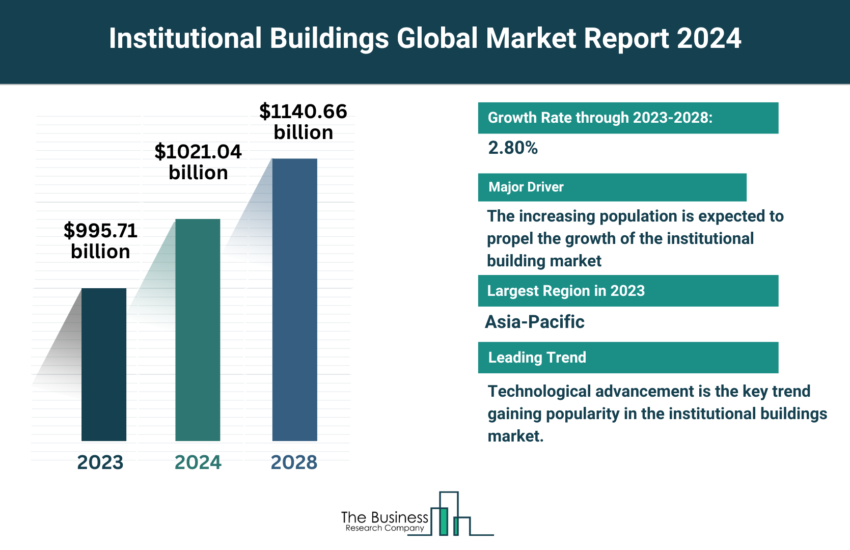Insights Into The Smart Buildings (Nonresidential Buildings) Market’s Growth Opportunities Through 2023-2032 – Includes Smart Buildings (Nonresidential Buildings) Market Size
The Business Research Company’s global market reports are now updated with the latest market sizing information for the year 2023 and forecasted to 2032
The increasing demand to automate tasks using IoT (Internet of Things) devices are expected to drive innovation in smart buildings (nonresidential buildings) manufacturing, thus driving the market during the forecast period.
The global smart buildings (nonresidential buildings) market is expected to grow from $56.18 billion in 2022 to $62.95 billion in 2023 at a compound annual growth rate (CAGR) of 12.1%. The global smart buildings (nonresidential buildings) market size is expected to grow to $99.76 billion in 2027 at a CAGR of 12.2%.
Get A Free Sample On The Global Smart Buildings (Nonresidential Buildings) Market Report:
https://www.thebusinessresearchcompany.com/sample.aspx?id=5482&type=smp
Global Smart Buildings (Nonresidential Buildings) Market Segments Include:
- By Automation Type: Intelligent Security System, Building Energy Management System, Infrastructure Management System, Network Management System
- By Application: Government, Airports, Hospitals, Institutes Manufacturing & Industrial facilities, Other Applications
- By Product Type: Institutional Buildings, Commercial Buildings
- By Type: New Constructions, Remodelling Projects
- By Geography: The market is segmented into North America, South America, Asia-Pacific, Eastern Europe, Western Europe, Middle East and Africa. Among these regions, Asia Pacific is the largest region in the global smart buildings (nonresidential buildings) market in 2021.
Major Market Players in the smart buildings (nonresidential buildings) market include Johnson Controls, ABB Ltd., Siemens AG, Honeywell International Inc., Hitachi, IBM, Schneider Electric.
The use of 5G technology is the latest trend in the smart building (non-residential) market. 5G technology is the upcoming cellular technology that reduces the time it takes for devices over a wireless network to communicate with each other. 5G implementation in smart buildings will considerably enhance the usage of wireless edge devices, providing rich multimedia experiences. 5G will also improve security check applications for commercial buildings. For smart hospital buildings, the use of 5G is estimated to improve the wayfinding that will enable smart wheelchairs and beds to move immobile patients. Following the trend, Ericsson, a Sweden-based networking and telecommunications company, invested $100 million to develop a smart factory in Texas for implementing 5G technology and rolled its first 5G radio device in 2020. The factory is involved in the manufacturing of advanced antenna system radios to enable rapid 5G deployments. The use of 5G technology is expected to improve the connectivity in smart buildings, thus forming a trend that is witnessing a huge capital investment by the major players in the smart building (non-residential) market.
The Smart Buildings (Nonresidential Buildings) Global Market Report 2023 provides a smart buildings (nonresidential buildings) market overview for the time series: historic years (2010 – 2021) and ten years forecast (2023 – 2032). The smart buildings (nonresidential buildings) market forecast analyzes smart buildings (nonresidential buildings) market size, smart buildings (nonresidential buildings) market share, leading competitor market positions. The regions covered in the report include Asia-Pacific, China, Western Europe, Eastern Europe, North America, USA, South America, Middle East and Africa and the countries include Australia, Brazil, China, France, Germany, India, Indonesia, Japan, Russia, South Korea, UK, USA.
Smart buildings (non-residential Buildings) construction is the process of building, altering, repairing, improving, or demolishing any non-residential smart home using a detailed design and plan. Smart homes are futuristic buildings equipped with advanced electronics and wireless devices. The smart home system requires a web portal or smartphone application to interact with the automated system as a user interface.
Explore Similar Reports From The Business Research Company:
Buildings Construction Global Market Report 2023
Nonresidential Building Construction Global Market Report 2023
Services To Buildings And Dwellings Global Market Report 2023
Learn More About The Business Research Company
The Business Research Company has published over 3000+ detailed industry reports, spanning over 3000+ market segments and 60 geographies. The reports draw on 1,500,000 datasets, extensive secondary research, and exclusive insights from interviews with industry leaders.
Contact us at:
The Business Research Company: https://www.thebusinessresearchcompany.com/
Americas +1 3156230293
Asia +44 2071930708
Europe +44 2071930708
Email us at info@tbrc.info
Follow us on:
LinkedIn: https://in.linkedin.com/company/the-business-research-company
YouTube: https://www.youtube.com/channel/UC24_fI0rV8cR5DxlCpgmyFQ
Global Market Model: https://www.thebusinessresearchcompany.com/global-market-model
Found this article helpful? Share it on:



